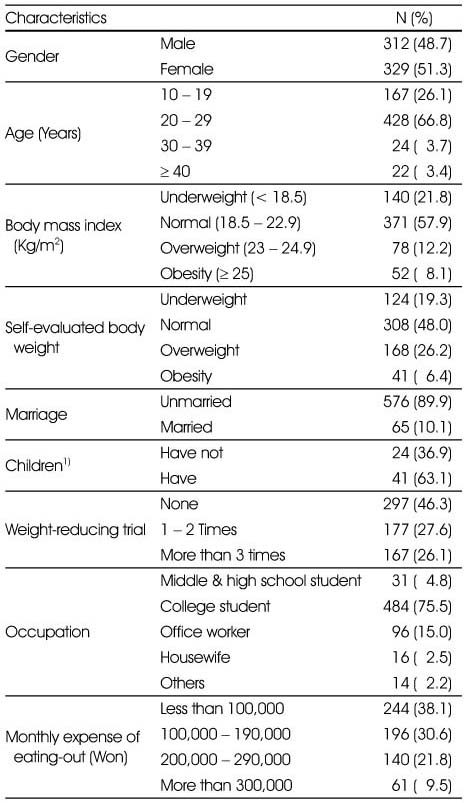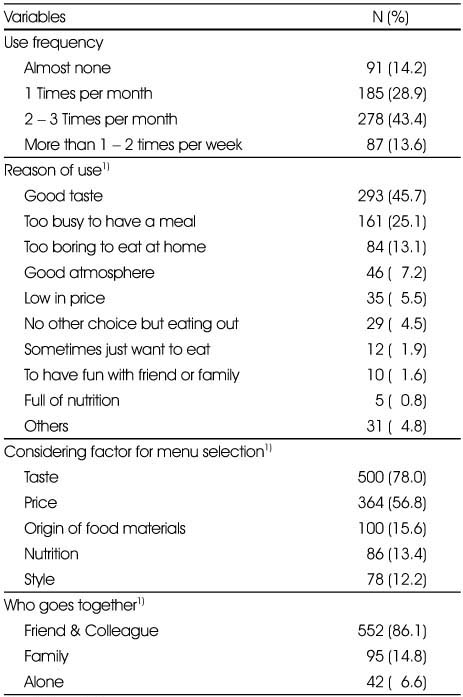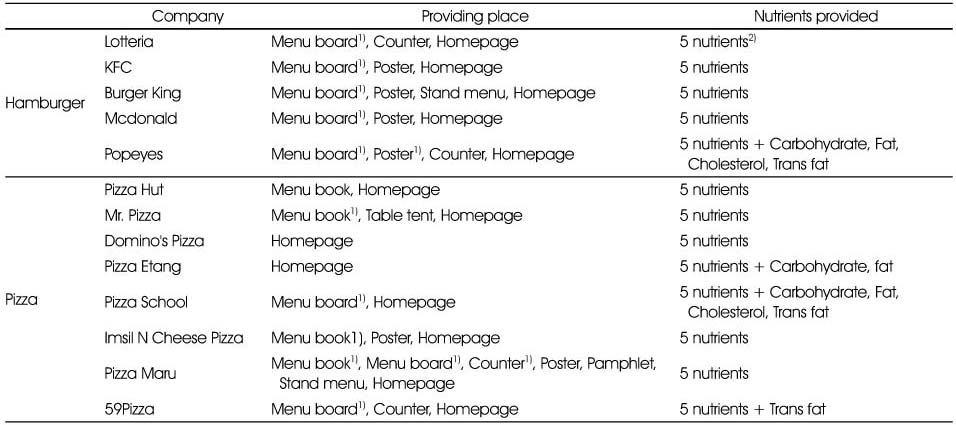References
1. Binkley JK, Eales J, Jekanowski M. The relation betweendietary change and rising US obesity. Int J Obes Relat Metab Disord 2000. 24(8)1032–1039.
2. Cho KS, Im BS, Kim SE, Kim GW. A survey on consumption behaviors of the fast-foods in university students. J Korean Living Sci Assoc 2005. 14(2)313–319.
3. Choi JH. A study on the consumption pattern and nutrition labeling recongnition of restaurant's of girl's highschool students 2009. Ulsan University; 4–27.
MS thesis.
4. Chung HJ, Cheon HS, Kwon KI, Kim JY, Yoo KS, Lee JH, Kim JW, Park HK, Kim SH, Hong SM. The recognition and requirement of nutrition labeling in fast-food restaurants. Korean J Nutr 2009. 42(1)68–77.
5. Chung SJ, Kang SH, Song SM, Ryu SH, Yoon JH. Nutritional quality of Korean adults' consumption of lunch prepared at home, commercial places, and institutions: analysis of the data from the 2001 national health and nutrition survey. Korean J Nutr 2006. 39(8)841–849.
6. Han MH. Consumption value and eating out behavior of male and female undergraduate students 2007. Catholic University; 34–45.
MS thesis.
8. Jeon MJ, Kim BH, Lee KS. A survey of fast food ding out behaviors. J Korean Home Econ Assoc 1990. 28(2)15–29.
9. Jun SM, Kwon SH, Park HK, Kim SH, Kwon KI, Jung HR. Consumers' use and demand of restaurant foods nutrition labeling. J Consum Stud 2009. 20(2)279–306.
10. Jung YH, Ko SJ, Lim HJ. The socioeconomic cost of adolescent obesity. Health Soc Welf Rev 2010. 30(1)195–219.
11. Kim BY. University student's dietary habit, and actual status of using convenience food and nutrition labelling 2010. Konkuk University; 40–48.
MS thesis.
12. Kim JH. The customer awareness and necessity about nutrition labeling system implementation of the menu. -Family Restaurant- 2009. Woosong University; 20–25.
MS thesis.
13. Kim KM. A study on fast food consumption patterns and brand preferene of university students in Ulsan 2009. Ulsan University; 8–20.
MS thesis.
14. Korea Center for Disease Control and Prevention. Reports on 2007~2008 Korea National Health and Nutrition Examination Survey 2010.
15. The public announcement 2009-286. Korea Food and Drug Administration 2009. cited 2010 November 25. Available from
http://www.kfda.go.kr.
16. Food Industry Statistics System. Korean National Statistical Office 2009. cited 2010 November 20. Available from
http://fis.foodinkorea.co.kr/.
17. Kwon KI, Yoon SW, Kim SJ, Kang HN, Kim HN, Kim JY, Kim SY, Kim KL, Lee JH, Jung SM, Ock SW, Lee EJ, Kim JW, Kim MC, Park HK. A survey on customers' perceptions of nutrition labeling for processed food and restaurant meal. Korean J Nutr 2010. 43(2)181–188.
18. Lee HJ. Understanding and the use of food nutrition label of high school students in Jeollabuk-do province 2009. Wonkwang University; 14–17.
MS thesis.
19. Lee JJ. Survey on the fast food consumption and nutrition knowledge of middle school students in Pohang city 2009. Yeungnam University; 7–20.
MS thesis.
20. Symposium: Present status of obesity and its countermeasures in Korea. Ministry of Health and Welfare & Korea Center for Disease Control and Prevention 2006. Cited 2010 November 11. Available from
http://www.cdc.go.kr/.
21. National household monthly food expenses. Ministry for Food, Agriculture, Forestry and Fisheries 2010. cited 2010 November 10. Available from
http://www.krei.re.kr/kor/main.php.
22. Socioeconomic expense for obesity in Korea. 2008 Estimation data of National Health Insurance Corporation. National Health Insurance Corporation 2010. cited 2010 November 20. Available from
http://www.nhic.or.kr/.
23. Nielsen SJ, Siega-Riz AM, Popkin BM. Trends in energy intake in U.S. between 1977 and 1996 similar shifts seen across age groups. Obes Res 2002. 10(5)370–378.
24. Sohn CY. Perception of nutrition labeling on restaurant menus among adults in Suwon. Korean J Community Nutr 2009. 14(4)420–429.
25. Shin AS, Roh SB. Fast food consumption patterns of college students in Busan. Korean J Food Cult 2000. 15(4)287–293.
26. Wang G, Fletcher SM, Carley DH. Consumer utilization of food labeling as a source of nutrition information. J Consum Aff 1995. 29(2)368–380.
27. Yoon HJ, Wi SU. A survey of college student behaviors on fast food restaurants. Korean J Food Nutr 1994. 7(4)323–331.
28. You YJ. A study on the consumption pattern and nutrition labeling recognition of restaurant's menu of middle school student by sex in Jiniu 2009. Ulsan University; 10–30.
MS thesis.










